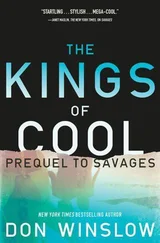Keller disappointed them.
He called a general meeting at which he said, “I’m not firing anybody. The knock on me is that I’m not an administrator and don’t have a clue how to run a gigantic organization. That rap is accurate—I don’t. What I do have is you. I will give clear, concise direction and I trust you to make the organization work toward those objectives. What I expect from you is loyalty, honesty and hard work. What you can expect from me is loyalty, honesty, hard work and support. I will never stab you in the back, but I will stab you in the chest if I catch you playing games. Don’t be afraid to make mistakes—only slackers and cowards don’t make mistakes. But if we have a problem, I don’t want to be the last to know. I want your thoughts and your criticisms. I’m a big believer in the battleground of ideas—I don’t need the only word, just the last word.”
He set priorities.
Next he called in the deputy administrator, Denton Howard, and the chiefs of Intelligence and Operations and told them that their first priority was heroin.
The second priority was heroin.
The third priority was heroin.
“We’ll sustain our efforts on all Schedule I drugs,” he told them, “but our overriding emphasis on the enforcement side is ending the heroin epidemic. I don’t care about marijuana, except where it can lead us up the ladder to the heroin traffickers.”
Which meant focusing on the Sinaloa cartel.
Keller’s approach is something of a departure—historically, Sinaloa hadn’t been greatly involved with heroin production since the 1970s, when the DEA and the Mexican military had burned and poisoned the poppy fields (Keller was there), and the growers turned to other products.
The Barrera wing of the cartel had made most of its money from cocaine and marijuana, the Esparza wing from methamphetamine, the Tapia faction from a combination of all three.
“It’s a mistake to put all our efforts into fighting them in Mexico,” Keller told his people. “I know, because it’s a mistake I made. Repeatedly. From now on we put our priority on hitting them where we can hit them—here in the United States.”
Howard said, “That’s a piecemeal approach that will require coordination from dozens of metropolitan police departments.”
“Set it up,” Keller said. “Within the next month I want face-to-face meetings with the chiefs of narcotics from New York, Chicago and Los Angeles. If they can’t or won’t come to me, I’ll go to them. After that, I want Boston, Detroit and San Diego. And so on. The days of standing at the urinal pissing on each other’s shoes are over.”
But great, Keller thought, I have a deputy who’s looking to sabotage me. I’m going to have to starve him out, and the way to starve a bureaucrat is to deprive him of access and information.
Keller kept Blair after the meeting. “Does Howard have a hard-on for me?”
Blair smiled. “He expected to get your desk.”
The administrator and deputy administrator of the DEA are political appointees—all the rest are civil servants who come up through the system. Keller figured that Howard probably thought O’Brien and his cabal fucked him.
The organizational chart has all the department heads reporting directly to Howard, who then reports to Keller.
“Anything significant,” Keller told Blair, “you bypass Howard, bring directly to me.”
“You want me to keep a double set of books.”
“You have a problem with that?”
“No,” Blair said. “I don’t trust the son of a bitch, either.”
“It blows up, I’ll cover your ass.”
“Who’s going to cover yours?” Blair asked.
Same person who always has, Keller thought.
Me.
“Let’s look at the velorio again,” Keller says.
Blair puts up the photos from Barrera’s wake, taken by an incredibly brave SEIDO undercover working as a waiter for the catering company that serviced the event. Keller stares at the dozens of photos—Elena Sánchez sitting by the coffin; the Esparza brothers; Ricardo Núñez and his son, Mini-Ric; a host of other important players. He studies photos taken in the house, on the lawn, out by the pool.
“Can you order them by time sequence?” Keller asks.
The cliché is that every picture tells a story, but a sequence of pictures, Keller thinks, can be more like a movie and tell a different story. He’s a big believer in chronology, in causation, and now he studies the photos with that sensibility.
Blair is smart enough to shut up.
Twenty minutes later, Keller starts to select a series of photos and lay them out in line. “Look at this—Núñez goes up to Elena. They walk outside, let’s say it’s to talk in private.” He highlights a series of photos that show Elena and Núñez walking closely together, in what seems to be intense conversation. Then—
“Shit,” Keller says, “what’s this?”
He zooms in on Núñez’s hands, on a piece of paper that he gives Elena.
“What is it?” Blair asks.
“Can’t make it out, but she’s sure as hell reading it.” Keller zooms in on Elena’s face—reading, frowning. “It could be the catering bill, who knows, but she isn’t happy.”
They look at pictures of Elena and Núñez in conversation and then check the time log. The conversation lasted for five minutes and twenty-two seconds. Elena gave Núñez the paper and went back inside the house.
“What I wouldn’t give for some audio,” Keller says.
“They were jamming,” Blair says.
Keller goes back to his timeline series of photos and notes Iván and Mini-Ric in what looks to be a casual conversation by the pool. Then Núñez comes out and walks away with Iván, leaving Ric sitting there. Half an hour later, by the time log, Iván comes back out and talks to Ric.
And it doesn’t look casual.
“Am I imagining things,” Keller says, “or are they in an argument?”
“Iván sure looks angry.”
“Whatever got his panties in a wad,” Keller says, “it had to have been when he was with Núñez. I don’t know, maybe I’m reading too much into this.”
And maybe not, he thinks.
All the drumbeats said that Iván was next in line to take control of the cartel, merging the Barrera and Esparza wings of the organization. But now we seem to be seeing Ricardo Núñez summoning Elena Sánchez and Iván Esparza to personal talks, after which Iván appears to be angry.
Jesus Christ, could we have missed something here?
Keller had thought of Ricardo Núñez as a midlevel functionary, at most some kind of adviser to Barrera, but he’s been playing an outsize role in the velorio and the funeral and now he seems to be some kind of go-between from Elena to Iván.
Negotiating what, though?
Elena’s been out of the trade for years.
Keller tries a different theory—maybe Núñez isn’t simply providing “good offices,” but has become a power in and of his own.
Stay tuned, Keller thinks.
¡ADÁN VIVE!
Elena Sánchez Barrera looks at the graffiti spray-painted on the stone wall of the Jardines del Valle cemetery.
She saw the same thing on the ride into the city, painted on walls, the sides of buildings, on billboards. She’s been told that the same phenomenon has occurred in Badiraguato and that little shrines to “Santo Adán” have shown up on roadsides in smaller towns and villages all across Sinaloa and Durango—the deeply felt, passionate wishful thinking that Adán Barrera—the beloved El Señor, El Patrón, the “Godfather,” the “Lord of the Skies,” the man who built clinics, schools, churches, who gave money to the poor and fed the hungry—is immortal, that he lives in flesh or spirit.
Saint Adán, indeed, she thinks.
Читать дальше












